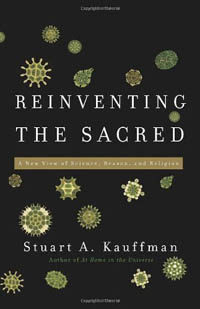October 27, 2010
Email to Stuart Kauffman re Reinventing the Sacred
I love to read about a great variety of subjects and I'm always amazed how the "state of the art" somehow manages to permeate the various subjects even if the authors don't know each other and possibly don't even know about each other. Word of mouth information dispersal was much accelerated by the printed word and the Internet has put the dispersal on hyper-drive. Reading about "the adjacent possible" in Kauffman brought to mind John Boyd's "destruction and creation" (analysis and synthesis) which is what motivated the following email I sent to professor Kauffman.

You are my favorite "Complexity Scientist." I'm not a scientist myself, far from it, but as an investor I am very much interested in the economy. I have been reading about complexity and increasing returns for some ten years including At Home in the Universe and more recently Reinventing the Sacred.
While I disagree with your religious conclusion about the need to have anything sacred, I find your economic discussions fascinating, specially "pre-adaptation" and "the adjacent possible."
It struck me that Colonel John Boyd made an excursion into the adjacent possible one of the pillars of his military doctrine. I don't know the date of this work but I believe it must be 20 or 25 years old at a minimum. Since this was a "practical" application of your theory about the adjacent possible I think you'll find it most interesting.
Colonel Boyd didn't write any books. As an Air Force officer, his method of communication was the briefing. Most of the Boyd material I have is from watching youTube presentations of his briefings and the handouts that accompanied them. One of Boyd's briefings is "Destruction and Creation," not to be confused with Schumpeter's earlier "Gales of destructive creation" which is a different process. Below I have extracted the excursion into the adjacent possible from a video and the accompanying notes. I think you'll find them interesting.

Forty Second Boyd


Illustration:This is not a serendipitous discovery that a motor block can function as a chassis. This is a mental process designed to explore the adjacent possible which he then used as a basis for his military doctrine, the OODA Loop. The presentation continues:
-Imagine that you are on a ski slope with other skiers-retain this image.
-Imagine that you are in Florida riding in an outboard motorboat-maybe even towing water-skiers-retain this image.
-Imagine that you are riding a bicycle on a nice spring day-retain this image.
-Imagine that you are a parent taking your son to a department store and that you notice he is fascinated by the tractors or tanks with rubber caterpillar treads-retain this image.
Now imagine that you:
-Pull skis off ski slope; discard and forget rest of image.
-Pull outboard motor out of motorboat; discard and forget rest of image.
-Pull handlebars off bicycle; discard and forget rest of image.
-Pull rubber treads off toy tractors or tanks; discard and forget rest of image.
This leaves us with:
Skis, outboard motor, handlebars, rubber treads
Pulling all this together
What do we have?
Snowmobile
? What does this example suggest ?
To discern what is going on we must interact in a variety of ways with our environment.
In other words
We must be able to examine the world from a number of perspectives so that we can generate mental images or impressions that correspond to that world.
More to the point
We will use this scheme of pulling things apart (analysis) and putting them back together (synthesis) in new combinations to find how apparently unrelated ideas and actions can be related to one another.
The audio of this illustration begins at around minute six of the second video. I've embedded the complete set of the Conceptual Spiral Presentation YouTube videos just in case you find it as fascinating as I do. They are at the foot of the page.

John Boyd is not the only one who has touched on some of your topics. In the section on algorithmic economic development you have a chart (Figure 11.3) plotting Grammar Diversity vs. Renewable Resource Diversity. Jared Diamond put it succinctly: "Opportunity (not necessity) is the mother of invention." He was referring to the availability of suitable wild grasses in the Fertile Crescent which led to the development of agriculture.
I am amazed by the number of economists who cling to "Newtonian" (Classical) Economics instead of embracing "Biological" (Evolutionary) Economics and politics. I believe many of the failed proposals for developing the Third World fail precisely because they are based on the failed Classical Economics. It would be grand if economists embraced the new view of their science which needs not be dismal at all. For just about anything that is "diminishing" we should be able to find alternatives or substitutes. How long are we going to have to put up with insane economists (Krugonomics) who recommend doing more of the same when their pet recommendations fail?
I enjoy reading your books but there is no such thing as a Jewish Atheist.
With best regards,
Denny Schlesinger
Reinventing the Sacred: A New View of Science, Reason, and Religion by Stuart Kauffman
Guns, Germs, and Steel: The Fates of Human Societies by Jared M. Diamond
The Mind of War: John Boyd and American Security by Grant T. Hammond
Introducing John Boyd
Conceptual Spiral Presentation by John Boyd 1
Conceptual Spiral Presentation by John Boyd 2
Conceptual Spiral Presentation by John Boyd 3
Conceptual Spiral Presentation by John Boyd 4
Conceptual Spiral Presentation by John Boyd 5
Conceptual Spiral Presentation by John Boyd 6
Conceptual Spiral Presentation by John Boyd 7
Conceptual Spiral Presentation by John Boyd 8
Edited July 17, 2018.
Copyright © Software Times, 2000, 2001, 2003. All rights reserved
Last updated March 8, 2009.
Last updated March 8, 2009.